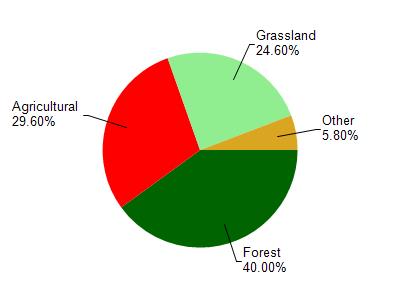Vernon
No
No
No
Fish and Aquatic Life
Overview
Runge Hollow Lake is a 45 acre impoundment at river mile 18 of the North Fork of the Bad Axe River. The 15 foot deep lake is sandwiched between two hills with an earthen dam (PL-566 structure) transecting the valley. A 2005 plant survey of this lake reported existence of Eurasian watermilfoil. Since the lake levels can be manipulated at the dam structure, the lake was drawn down over the winter of 2005-06 to expose this invasive plant species and the sediments it grows in to freezing temperatures. A re-survey of this lake in 2006 after the water levels were returned to normal did not document Eurasian watermilfoil. This lake is a popular fishing lake for area citizens. The land surrounding Runge Hollow Lake is all privately owned. An easement was given for a parking lot, fishing pier and boat launch at Runge Hollow Lake. A 2003 fish survey documented largemouth bass, bluegill, black crappie, green sunfish, carp, and white sucker.
An early spring snowmelt event took place on March 8-9, 2005 in south western Wisconsin. Manure spreading of farm fields was prevalent during this unusually early warm spell. Runoff of snowmelt with recently applied manure caused a major fish kill of Jersey Valley Lake, an impoundment in a neighboring watershed. This event prompted monitoring of Runge Hollow Lake. On March 10, 2005 Runge Hollow Lake did contain areas of very low dissolved oxygen, however there was a zone of refuge for fish containing between 8 and 9 mg/l of dissolved oxygen. A follow up survey on March 29, 2005 showed a larger area of low dissolved oxygen but also a larger total area of adequate levels. The watershed of Runge Hollow Lake is much larger than Sidie Hollow Lake and contains a larger percentage of farm fields that may have been spread with manure prior to the snowmelt. Runge Hollow Lake is certainly susceptible to winterkill due to manure laden snowmelt, but did not kill during this March 2005 event.
Date 2010
Author Cynthia Koperski
Condition
Wisconsin has over 84,000 miles of streams, 15,000 lakes and milllions of acres of wetlands. Assessing the condition of this vast amount of water is challenging. The state's water monitoring program uses a media-based, cross-program approach to analyze water condition. An updated monitoring strategy (2015-2020) is now available. Compliance with Clean Water Act fishable, swimmable standards are located in the Executive Summary of Water Condition in 2018. See also the 'monitoring and projects' tab.
Reports
Recommendations
Lakes Planning Grant
1641700 North Fork Bad Axe River
1642400 Runge Hollow Lake
Management Goals
Wisconsin's Water Quality Standards provide qualitative and quantitative goals for waters that are protective of Fishable, Swimmable conditions [Learn more]. Waters that do not meet water quality standards are considered impaired and restoration actions are planned and carried out until the water is once again fishable and swimmable
Management goals can include creation or implementation of a Total Maximum Daily Load analysis, a Nine Key Element Plan, or other restoration work, education and outreach and more. If specific recommendations exist for this water, they will be displayed below online.
Monitoring
Monitoring the condition of a river, stream, or lake includes gathering physical, chemical, biological, and habitat data. Comprehensive studies often gather all these parameters in great detail, while lighter assessment events will involve sampling physical, chemical and biological data such as macroinvertebrates. Aquatic macroinvertebrates and fish communities integrate watershed or catchment condition, providing great insight into overall ecosystem health. Chemical and habitat parameters tell researchers more about human induced problems including contaminated runoff, point source dischargers, or habitat issues that foster or limit the potential of aquatic communities to thrive in a given area. Wisconsin's Water Monitoring Strategy was recenty updated.
Grants and Management Projects
Monitoring Projects
| WBIC | Official Waterbody Name | Station ID | Station Name | Earliest Fieldwork Date | Latest Fieldwork Date | View Station | View Data |
|---|
| 1642400 | Runge Hollow Lake | 10015157 | Runge Hollow Lake 2003 Survey | | | Map | Data |
| 1642400 | Runge Hollow Lake | 633079 | Runge Hollow Lake - Deep Hole | 2/22/1994 | 3/19/2007 | Map | Data |
| 1642400 | Runge Hollow Lake | 10005955 | Runge Hollow Lake | 8/8/2001 | 9/2/2016 | Map | Data |
| 1642400 | Runge Hollow Lake | 10018007 | North Fork Bad Axe River -- Access | | | Map | Data |
|

Watershed Characteristics
Runge Hollow Lake is located in the Bad Axe River watershed which is 195.49 mi². Land use in the watershed is primarily forest (40%), agricultural (29.60%) and a mix of grassland (24.60%) and other uses (5.80%). This watershed has 468.27 stream miles, 489.81 lake acres and 2,552.28 wetland acres.
Nonpoint Source Characteristics
This watershed is ranked High for runoff impacts on streams, Not Ranked for runoff impacts on lakes and Low for runoff impacts on groundwater and therefore has an overall rank of Low. This value can be used in ranking the watershed or individual waterbodies for grant funding under state and county programs.However, all waters are affected by diffuse pollutant sources regardless of initial water quality. Applications for specific runoff projects under state or county grant programs may be pursued. For more information, go to surface water program grants.